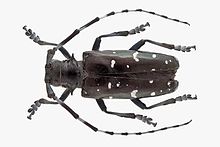Asian longhorn beetle
| Asian long-horned beetle | |
|---|---|
 |
|
|
Not evaluated (IUCN 3.1)
|
|
| Scientific classification | |
| Kingdom: | Animalia |
| Phylum: | Arthropoda |
| Class: | Insecta |
| Order: | Coleoptera |
| Family: | Cerambycidae |
| Subfamily: | Lamiinae |
| Tribe: | Monochamini |
| Genus: | Anoplophora |
| Species: | A. glabripennis |
| Binomial name | |
|
Anoplophora glabripennis (Motschulsky, 1853) |
|
| Synonyms | |
|
|
The Asian long-horned beetle (Anoplophora glabripennis), also known as the starry sky, sky beetle, or ALB, is native to eastern China, Japan, and Korea. This species has now been accidentally introduced into the United States, where it was first discovered in 1996, as well as Canada, Trinidad, and several countries in Europe, including Austria, France, Germany, Italy and UK. This beetle is believed to have been spread from Asia in solid wood packaging material.
Common names for Anoplophora glabripennis in Asia are the starry sky beetle, basicosta white-spotted longicorn beetle, or smooth shoulder-longicorn, and it is called the Asian long-horned beetle (ALB) in North America.
Adults are very large insects with bodies ranging from 1.7 to 3.9 cm (0.67 to 1.54 in) in length and antennae which can be as long as 4 cm (1.6 in) or 1.5–2 times longer than the body of the insect. They are shiny black with about 20 white spots on each wing cover and long antennae conspicuously banded black and white. These beetles can fly, but generally only for short distances, which is a common limitation for Cerambycidae of their size and weight. The upper sections of the legs of the adults are whitish-blue. ALB can be distinguished from related species by the markings on the wing covers and the pattern of the antennae.
Asian long-horned beetle is native to eastern Asia, primarily in eastern China, Korea, and Japan. It is invasive outside its native range.
In its native range, ALB primarily infest trees maple, poplar, willow, and elm. In the United States, ALB has completed development on species of these genera and also Aesculus, Albizia, birch, katsura, ash, planes, and Sorbus. In Canada, complete development has been confirmed only on maple, birch, poplar, and willow, although oviposition has occurred on other tree genera. Maple is the most commonly infested tree genus in North America, followed by elm and willow. In Europe, complete development has been recorded on maple, Aesculus, alder, birch, hornbeam, beech, ash, planes, poplar, Prunus, willow, and Sorbus. The top five host genera infested in Europe, in decreasing order, are maple, birch, willow, Aesculus, and poplar. Not all poplar species are equally susceptible to ALB attack.
...
Wikipedia
